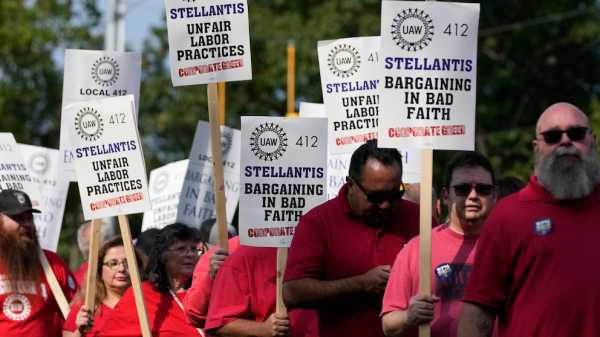
General Motors and Stellantis announced fresh layoffs Wednesday that they blamed on damage from the United Auto Workers strike, and the labor standoff grew more tense just two days before the union was expected to call for new walkouts.
Stellantis provided a glimmer of hope for a breakthrough by giving the union a new contract proposal. However, a company spokeswoman said the offer primarily covered non-economic issues.
It was not clear whether the Stellantis offer would satisfy union President Shawn Fain, who vows to announce new strike targets on Friday unless there is “serious progress” toward agreements with GM, Stellantis and Ford.
So far UAW workers are striking at just three factories, one for each company. It's a novel approach for the union, which in the past has focused negotiations on one company and limited a 2019 strike to GM. Fain says his approach will keep the companies guessing about UAW's next move.
“He is trying to distinguish himself from the old leadership of the UAW,” said Harry Katz, a professor of collective bargaining at Cornell University. “He's different, he's tough, and he's trying to put pressure on the companies.”
The three-plant strike has so far had limited impact on the automakers — probably by design, longtime industry observers say.
“The strategy is to incrementally apply pressure on the companies to encourage them to come to the table,” said Marick Masters, a management professor at Wayne State University in Detroit. “He is negotiating with the three companies simultaneously with the expectation that the one that is most vulnerable and will give them the best deal will surface from that strategy.”
However, if there is little sign of progress in the talks by Friday, Fain could take a more aggressive tack, “and they are going to strike where it hurts,” said Daniel Ives, an analyst at Wedbush Securities. “For Ford, on the pickups — disrupting (production of) F-150s, and strategically striking GM and Stellantis in a way that could substantially impair 30% to 40% of the industry's production.”
Strikes that target production of popular models like the F-150 or the Dodge Ram would inflict a lot of pain on the carmakers, but the UAW could pack the same punch if it walks out of key engine and transmission plants.
Another clue of possible strike targets might be found in locations where UAW locals have announced they will hold rallies and practice picketing in the coming days. Those include a Ford plant in Louisville, Kentucky, a GM plant in Bedford, Illinois, and a GM truck plant in Arlington, Texas.
“If Friday comes and there is no major progress” at the bargaining table, “this will get a lot nastier,” Ives said.
The layoffs that GM and Stellantis announced Wednesday will be in Kansas, Ohio and Indiana.
GM said that the UAW strike at its assembly plant near St. Louis caused it to idle a plant in Kansas with about 2,000 workers because “there is no work available" — the plant depends on parts stamped in the St. Louis-area facility.
GM said it does not expect to restart the Kansas plant until the strike ends, and it won't provide supplemental pay to the workers. The company said the layoffs demonstrated “that nobody wins in a strike.”
Stellantis, which makes Jeep, Chrysler and Dodge vehicles, said it expects to lay off more than 300 workers in Ohio and Indiana because “storage constraints” caused by the UAW strike at its assembly plant in Toledo, Ohio.
Asked for comment, a UAW spokesman referred to a statement last weekend in which UAW President Shawn Fain said layoffs were unnecessary and an effort to pressure workers to settle for less in contract negotiations.
Also Wednesday, about 190 UAW members walked off the job at ZF, a Mercedes supplier in Alabama, over wages, a lower scale for new workers, and health care benefits. The workers are covered under a different contract than those that UAW is negotiating with the three big automakers. A ZF spokesman said the plant was continuing to run, and the company hopes to reach an agreement with the workers soon.
The layoffs and the Alabama walkout ratcheted up tension two days before Friday's UAW deadline for the carmakers to show progress in meeting the UAW's demands. The union and the car makers continue to talk, but an industry official said Wednesday that the two sides remain far apart.
The UAW is seeking pay raises of more than 30% over four years, a restoration of defined-benefit pensions for all workers, and a 32-hour work week for 40 hours of pay. The companies are offering around 20% on pay and are staunchly resisting some of the union's other demands.
There was progress between one automaker and a labor union, but it happened in Canada.
Ford and Unifor, which represents Canadian auto workers, announced that they reached a tentative agreement on a new three-year contract just hours before a strike deadline. Terms of the deal were not disclosed. If ratified, it would cover more than 5,000 workers and provide a model for similar deals at GM and Stellantis operations in Canada.
Sourse: abcnews.go.com






